17/10/16
Myth-Making and
Myth-Breaking: Wendy Elia and the Constitutive Other
Wendy Elia: Paintings 2004-2016
Thames-Side Studios Gallery
18 – 22 October 2016
One of the founding ideas on which theories of consciousness
and identity tend to be built is the binary of the self and the other. Put
simply, the existence of an other, a not-self, allows for the possibility or
recognition of a self. This self/other binary is an accepted division of how
the modern individual comprehends who s/he is, by recognising what s/he is not.[1] In
the late 18th century, Georg Wilhelm Friedrich Hegel (1770-1831) introduced the
concept of the other as a constituent part of self-consciousness (preoccupation
with the self). In phenomenology, the terms other and the constitutive other
each identify a cumulative, constituting factor in the self-image of a person;
his or her acknowledgement of being real. While the other is dissimilar to and
the opposite of the self, the constitutive other is the relation between the
essential nature (personality) and the outward manifestation of a human being;
it is the relation between the self and the projection of the self. Advancing
this one step further, Edmund Husserl (1859-1938) applied the concept of the other
as a basis for intersubjectivity, the psychological relations among people.[2]
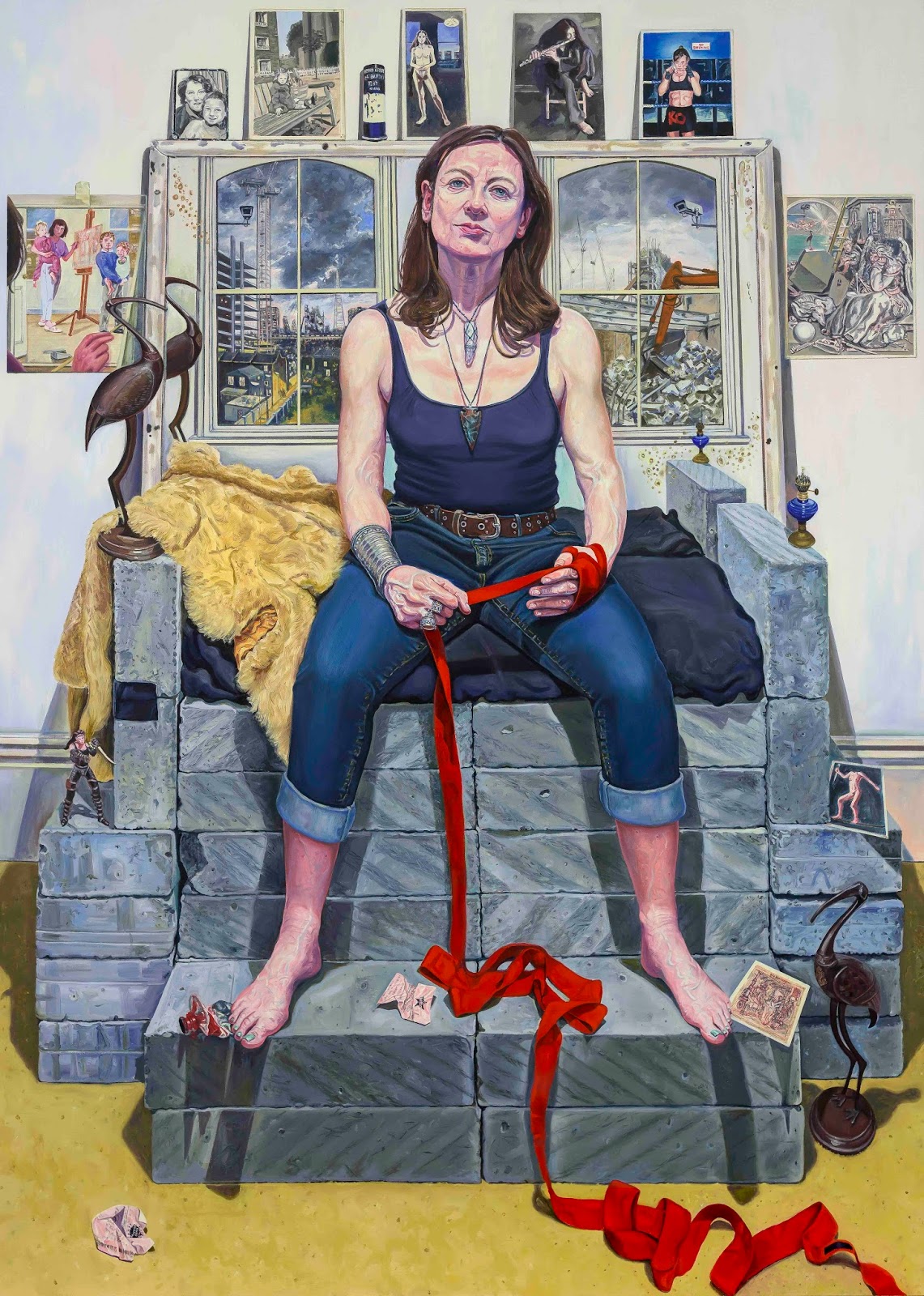
Throughout history, the artist has sought, through representational
painting, to recreate an image of him/herself, or the other, capturing some
element of likeness, be it visual or psychological. In the wake of photography,
painting has often been placed in second rank, or artists have sought to
emulate the ‘photorealism’ of the camera. Wendy Elia (b1953), however, is a
painter who exhalts the illusory qualities of pigment. ‘The hyperreal is
supposedly a simulation of reality,’ she says, ‘whereas the figures I’m dealing
with are real. All painting, you could say, is a simulation. I draw attention
to the fact that it’s a painting, rather than trying to create some simulation
of reality.’
Elia stands in a tradition of women artists, who seek to
invert and challenge the modes of self-portraiture and history painting, which
reinforce the masculinity of the artist in both myth and history. As Marsha
Meskimmon notes, in her exploration of women artists and self-portraiture:
‘This has been a necessary exercise for women who wished to represent
themselves as “the artist”, since standard means by which this was signified
were defined in ways exclusive of women. In some cases, it was enough merely to
show yourself with the tools of the trade to subvert convention and declare
yourself an independent woman. At other times, more active parodies and
pastiches of the tropes associated with the artist myth were needed to find a
place from which the woman as artist could speak. Whichever tack was taken,
women’s representations of themselves which engaged with artist definitions
altered those definitions and the very ways in which self-portraiture as a
genre can be read.’[3]
Over the years, Elia has experimented with other ways of
working – using photographs and film stills – but now she has come full circle
and returned to painting people she knows, from life. ‘At art school,’ she
remembers, ‘everybody was still bowing at the altar of Greenberg and the whole
idea of modernism, minimalism and abstract expressionism. But I just wanted to
paint figuratively, which was very unfashionable at the time. I was looking
towards Velázquez and Courbet, Freud and Manet. I saw myself as a realist.’ In
terms both of being a woman and pursuing her own will, Elia was, as well,
‘other’. Elia’s subjects – herself, her family and friends – mainly, albeit not
quite exclusively, women – challenge the viewer with an uncomfortably direct
gaze, they resemble their subject, but much more is revealed about them from
the painting as a whole, filled with clues and objects that play a part in
building the outward manifestation of the self; the objects that facilitate the
constitutive other.
Referencing the literary autobiography, Meskimmon proposes
that to analyse (or, frequently, psychoanalyse)
the significant or formative events in an individual’s life has been assumed to
explain his or her achievements. ‘There is proposed a transparent and immediate
relationship between the subject of the work itself and the author. That is, it
is assumed that the “I” of the autobiography is the writer, who stands
objectively outside the text, “accurately” rendering the events of his life. […]
It presumes the author to be able to understand and represent fully his or her
“self”, that the author is not in flux, but a fully formed and independent
subject who “knows” all about the self he represents. Thus the autobiography
reveals to us as readers the psychology of the author without any lacunae or myth-making.’[4] While
this might carry over to Elia’s painting to the extent that she is, both for
her paintings of others and of herself, standing outside, analysing formative
events and key moments, it is not true that she seeks to present a whole and
accurate vision. Elia avers that painting is both an exercise in myth-making
and a construct. The images she presents of others are the images she projects
of them. In an almost Brechtian manner, she seeks to undo this idea of
representing a complete illusion, by deliberately painting each individual
aspect, ingredient, metaphor or concept, uncovering the workings of identity and
interrogating the constitutive other.
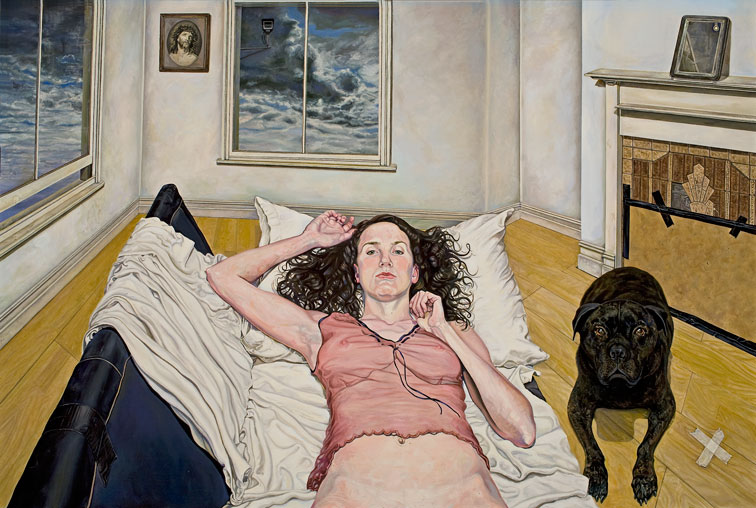
Few people’s identities or senses of self are defined in
relation to one sole other, however. For most of us, what makes us unique is
the complex of different identities that we embody, comprising memories and
experiences that are political, religious, national, local, linguistic, social
and collective in nature. Western portrait painters since the Renaissance have
often included objects or symbols in their prints, drawings and paintings, designed
to add to our knowledge of the identity and character of the subject. Sir
Joshua Reynolds’ Self-Portrait as DCL
(Doctor of Civic Law awarded from Oxford 1773) (1773), for example, associates
the artist with numerous great predecessors: the use of light and texture recalls
Rembrandt; the pose is borrowed from Van Dyck; and he is leaning on a table on
which sits a bust of Michelangelo.[5] Elia
too includes such motifs and signifiers in her work. Like James Joyce’s
compilation of stream of consciousness motifs in A Portrait of the Artist as a Young Man (1916), she accumulates diachronic
motifs from her own and others’ lives, producing visual collages of the selves
as ‘products of shifting social constructs’.[6] In his
psychological study of narration and its contribution to self and identity,
Michael Bamberg draws a distinction between the synchronic self and identity,
describing the latter as the ‘diachronic, temporal self’. He suggests: ‘Self,
as differentiated from other, developing the ability to account for itself (as
agent or as undergoer), self-reflect and self-augment, can now begin to look
for something like temporal continuity, unity, and coherence.’[7]
Set within her studio, Elia’s Portrait of the Artist as an Old Woman (2015) is a case in point,
abounding with references to her younger self; to hobbies; to interests; to her
working class roots; and to other artists. The title itself references
Rembrandt’s self-portrait, Portrait of
the Artist as a Young Man (1629-31), made at a time when the sense of self
was defined by one’s place in the world, prior to the Romantic notion of
subjectivity. By seating herself on a throne of concrete breezeblocks – a ‘poor
girl’s throne’ – Elia alludes to her upbringing, as she also does by having a rabbit
fur coat slung over its arm. The tower blocks, which have appeared in almost
all of Elia’s other paintings for the past two decades, have disappeared here,
being replaced by bulldozers and the foundations for luxury apartments. Elia,
once a martial artist, is shown putting on red boxing wraps – also
interpretable metaphorically as representing the struggling painter as a female
warrior, taking on the (art) world. She traces the narrative of a fighting life
through the use of smaller images and objects, which allude to both the
personal and the cultural: a photo of Elia’s younger self; a figurine of a
female fighter; the arrow head around her neck; a rubber bullet; a tube of
paint crushed beneath her foot. The complex staging of the painting (the
mirror, the frames within frames) remind us of the constructedness of the image
and introduces further different time zones. Elia’s studio, on the other hand,
represents a constant throughout her career. On the left of the mirror is a smaller
picture of the artist (again her younger self) painting, her children in the
frame. There is also a dustpan and brush in the image she is painting, a
reminder perhaps of the struggle between domesticity and professional practice
(‘the pram in the hall’ syndrome). Other images around the mirror include the
painter as musician, recalling Angelica Kauffman’s Self-portrait of the Artist hesitating between the Arts of Music and
Painting (1791), and Dürer’s Melancholia
I (1514), appropriated and placed on the right, paralleling the main image,
depicting, as it does, a women surrounded by tools. Elia has infiltrated the
mysterious image with symbols that commonly appear in her own paintings – the
ibis and the surveillance camera. As well as inserting herself into this
classical work, she is alluding to her own temperament as an artist.
Another artist who presents diachronic imagery as a form of
autobiographical chronology is the American photographer, Tee Corinne
(1943-2006). A Self-portrait Dialogue
with Time and Circumstance (1967-92), for example, is a photomontage
comprising multiple images of the artist taken over a 25-year period. Since she
has not dated any of the individual images, however, nor standardised the
self-portrait format, the work plays on the instability of the ‘self’ of the
title, revealing, much as Elia does with her painting, the multiple and
disparate nature of a self in time, rather than a chronological progression or psychological
portrait ‘without lacunae’. In My
Grandparents, Parents and I (1936), Frida Kahlo similarly uses this sense
of the personal passage of time, referring her own self to a sense of personal,
genealogical chronology, through the integration of her own image with that of
her family line. Meskimmon claims that, in its assertion of domestic time, this
painting subverts ‘a masculinist progressive sense of chronology’.[8] Elia,
in contrast, references both this domestic time (with the imagery of her
children and the dustpan and brush), but also a wider society and, as discussed,
the traditionally masculine comparisons with her predecessors in art history.
Simone de Beauvoir applied the other in her description of a
male-dominated culture, arguing that woman is treated subordinately as the other
in relation to man. Man represents both the positive and the neutral, as
indicated by the use of the term to designate human beings in general, while woman
represents only the negative, defined by limiting criteria.[9] She
proposed that women can only free themselves by ‘thinking, taking action,
working, creating, on the same terms as men’[10]. Through
her adoption of both gendered approaches to representing the diachronic self, Elia
firmly asserts the woman as the self – albeit incorporating, as well as
rejecting, the other.
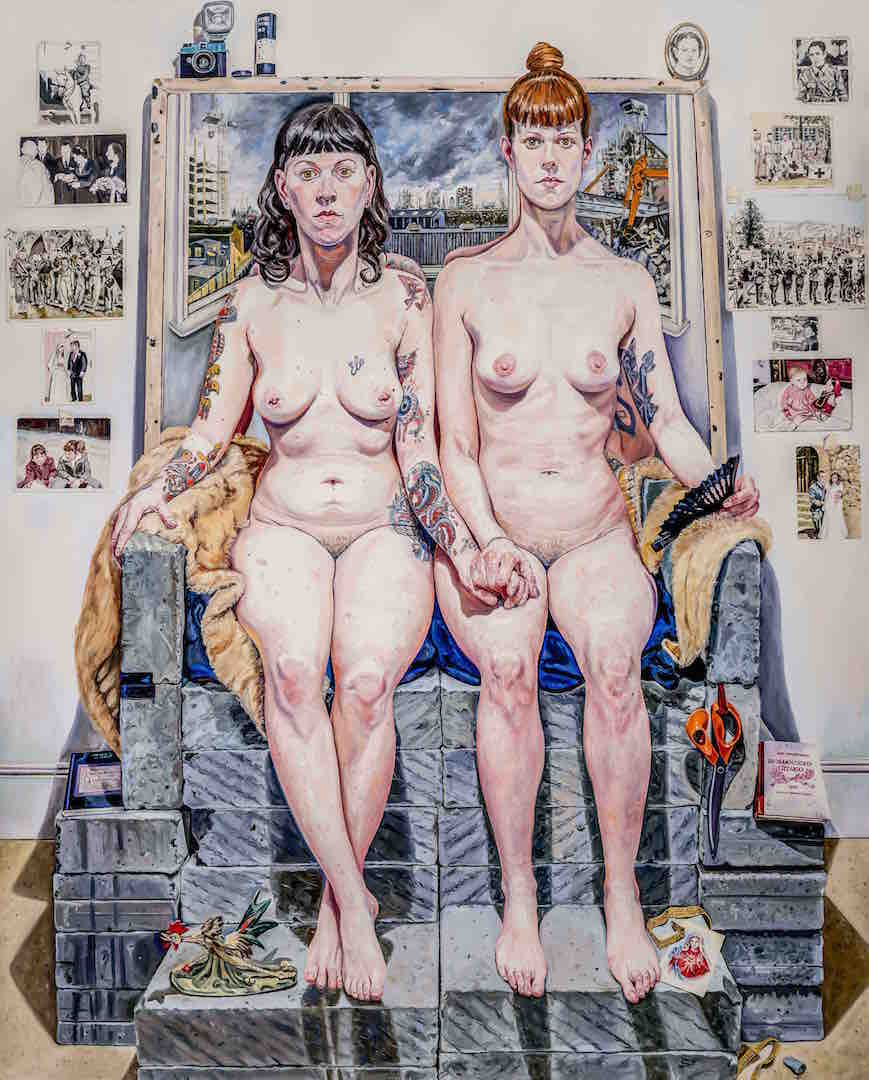
It is not just in this way that Elia incorporates the other
into the self – and, indeed, vice versa – for her signifying motifs recur
across the board, in both self-portraits and paintings of others. The recent
work, Carmen and Luisa (2016), for
example, reprises much of the composition of Portrait of the Artist as an Old Woman. Elia terms both ‘history paintings’,
since, as discussed, they bring in images and references from the past,
creating a diachronic overview of the subject(s). Here, the two women – performance
artists, originally from Spain (and other in terms of sexuality, nationality
and class) – are surrounded by photographs or their younger selves and families
(including their grandparents), significant childhood objects, and pictures of
the Spanish Civil War (in which their grandfathers were on opposing sides). Once
again, they are sitting on a concrete throne, on a rabbit fur coat, set against
the backdrop of a London building site with the ubiquitous surveillance camera
peering through the window. Religious references appear in the photo of Carmen
at her Holy Communion, and with the picture of the Virgin Mary at her feet,
implying, as for Elia, the rejection of this faith.
Another painting with a similar internal frame, comprising
old photographs around a mirror is Made In Britain (2011-12), which
portrays six young women – Elia’s own daughter and daughters of friends –
questioning what it means to be British in the modern day multicultural
society. What defines a Brit? What defines someone who is other?
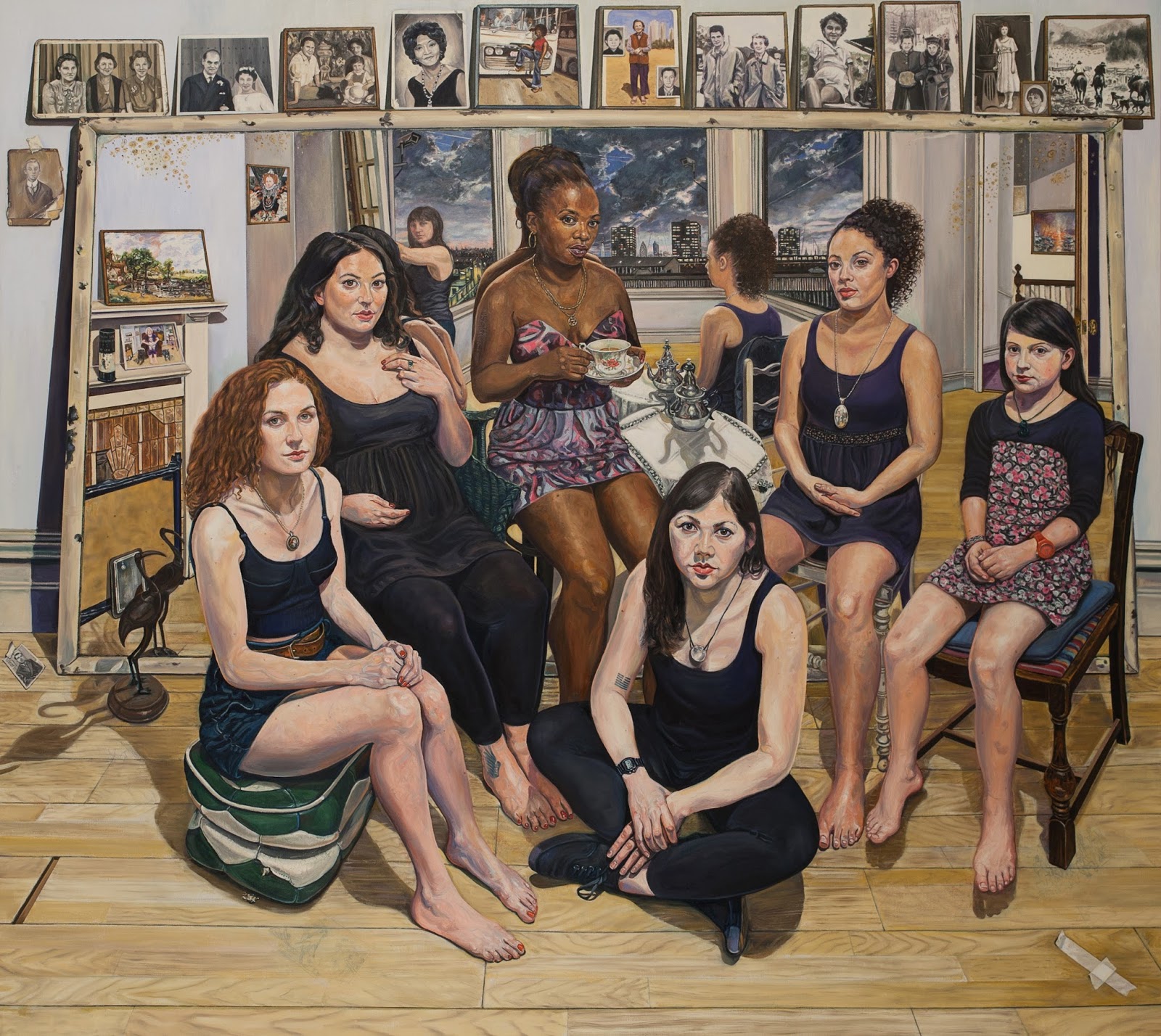
Further paintings in the exhibition employ a repeating
lexicon of motifs, including the ibis, a rubber bullet canister (picked up in
Ireland at the time of the Troubles and a signifier for the ever present power
of the state), a laminate floor (another nod to Elia’s Brechtian bent for
highlighting the construct and artifice, using a flooring that is made to look
like wood flooring but isn’t, standing as a metaphor for painting that’s
supposed to look like the real world but equally is not) and masking tape. Both
of the latter are present throughout The Visit series (2006-2011), where sitters are exposed to
the gaze of the viewer, as they lie naked, vulnerable and yet, as is especially
suggested in The Visit III (2009), with the sharpened finger nails and
background painting of Samson and Delilah, still strong. In Elia’s paintings of
her one time muse, the transgender artist Maxime (other in terms of non-binary
sexual identity), the symbolism becomes even more overt. In Maxime (2010),
for example, the masking tape under the chair marks the foot positions of
previous sitters and accumulates in a layering of past presences. Maxime’s contorted
and constrained body sits uncomfortably on an upright seat, her feet shoved
into pointed shoes, pushing forward, straining beyond the tape, which marks her
position – becoming something still other than the other already embodied.
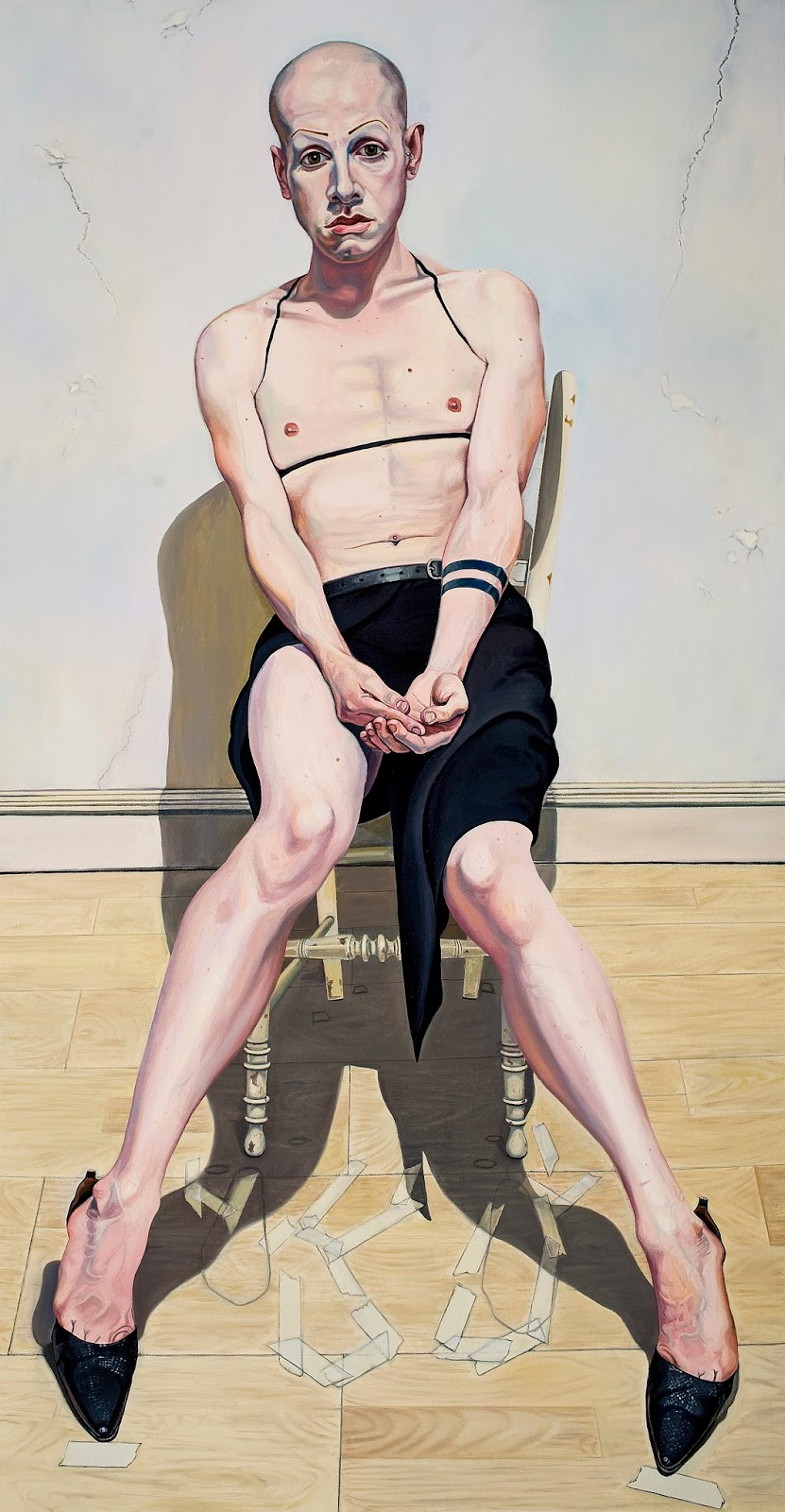
Breaking with the standard thesis, feminist scholar Sami
Schalk proposes an approach to the self/other binary, which opens up the
possibilities for relations between individuals by including a third term, the
other-self, permitting a fluid, contextualised understanding of the self in a
spectrum of triangulating relatedness to others at any given moment.[11] The
idea of double consciousness, of the existence of both/and within the
psychology and identity of an individual – as exemplified in Elia’s paintings,
in which the artist sees aspects of herself in her other subjects, and aspects
of her other subjects in herself – complicates the stark boundaries of the
self/other binary. The argument for a third possibility, namely Schalk’s
other-self, is supported further by psychological research in which ‘the self
is often viewed as fundamentally interpersonal, composed of a repertoire of
relational selves’.[12] The
basic self/other binary makes sense in as far as when one sees another person
and recognises that that individual is separate physically and mentally, then
one understands that the separate person is not the self. In a survey of
psychological research on the self, however, David A Kenny and Tessa V West conclude
that ‘the relationship between self-perception and perception of others is
bidirectional’, so although the basic theoretical division may be clear, the
psychological influence is not.[13]
In these situations, the psychological term ‘metaperception’
is significant. Metaperception might be understood as ‘what people think others
think of them’ and it ‘plays a key role in the formation of the self-concept…
more so than other perceptions’.[14] It
is metaperception that makes the self think about how the other perceives it, thus integrating aspects of the other
into its constitutive other, creating an other-self, much like the self-aware
subjects in Elia’sThe Visitseries,
being gazed upon, but holding that gaze firmly, as both sets of eyes
contemplate what they see. As Schalk notes, this definition of metaperception
almost explicitly replicates WEB Du Bois’ explanation of double consciousness
as ‘the sense of always looking at one’s self through the eyes of others’.[15]Elia, however, is trying to look at herself (and others) through her own eyes –
and to make us, the viewers, look at herself and others throughhereyes as well. As such, she turns the
concept of double consciousness on its head. Yet, at the same time, the motifs
and signifiers that she uses are external objects, as seen by others, or external
representations of events and memories. So whose eyes is it all really being
seen through? Maybe it is always a conjunction of Elia’s eyes, the eyes of
those who are looking and have looked at her, and our eyes now, as we look at
the paintings?

In Being and
Nothingness, Jean-Paul Sartre applied the Husserlian dialectic of intersubjectivity
to describe how the world is altered upon the appearance of an other person, of
how it then appears oriented towards this other person and no longer towards
the self.[16] Put
another way, an encounter with the other puts new experiences in our life,
which irrevocably alter the self and the constitutive other. Friedrich
Nietzsche, in On Truth and
Lying in a Non-Moral Sense notes: ‘Truth is a mobile army of metaphors,
metonyms, anthropomorphisms, in short a sum of human relations which have been
subjected to poetic and rhetorical intensification, translation and decoration
[…]; truths are illusions of which we have forgotten that they are illusions,
metaphors which have become worn by frequent use and have lost all sensuous
vigour.’[17] It might be said then, that when Elia’s
stack of metaphors and motifs for the self (herself or another self), as near
to hackneyed as they become, start to resemble a truth, it is the other that
steps in and confounds this illusion, lifting the stage curtain and revealing
the tropes.
‘All painting,’ maintains Elia, ‘is a lie. By the very
nature of taking three-dimensional space and putting it on to a two-dimensional
plane, all painting is a construct. Once you accept that it’s all a lie, it
liberates you, you’re free to do what you want. There are artists in history
who have been trying to get to the truth. Even cubism was about trying to show
the world as we really experience it, rather than from a one-dimensional
viewpoint. There is no truth. You’re always asking questions.’ Likewise, there
is no stable self, rather just an ever-fluctuating other-self, a myth-making
constitutive other, which can be interrogated through the medium of painting,
itself a form of encipherment – actively encrypting and decrypting as it tells
its tale.
[1] Sami Schalk (2011) ‘Self, other and other-self: going
beyond the self/other binary in contemporary consciousness’ in Journal of Comparative Research in
Anthropology and Sociology, volume 2, number 1, spring 2011
[2] See the Wikipedia entry on ‘Other’: https://en.wikipedia.org/wiki/Other
[accessed 02/10/16]
[3] Marsha Meskimmon (1966) The Art of Reflection. Women Artists’ Self-Portraiture in the Twentieth
Century (London: Scarlet Press) pp62-63
[4] ibid,
p67
[5] British
Museum. Art and Design: Identity. Guide
for Teachers.
https://www.britishmuseum.org/pdf/Art_guide_07Identityb_KS2-4.pdf [accessed 02/10/16]
[6] Meskimmon
(1966), p73
[7] Michael Bamberg (2011) ‘Who am I? Narration and its
contribution to self and identity’ in Theory
of Psychology, 21 (1) pp3-24, p12
[8]
Meskimmon
(1966), p74
[9] Carole McCann & Kim, Seung-Kyung (2003) Feminist Theory Reader: Local and Global
Perspectives (New York: Routledge) p33
[10] Simone de Beauvoir (1952/1993) The Second Sex (New York: Knopf) p752
[11] Schalk (2011)
[12] David A Kenny & Tessa V West (2008)
‘Self-Perception as Interpersonal Perception’ in Joanne V Wood et al (ed) The Self and Social Relationships (New
York: Psychology Press) p120, cited in Schalk (2011)
[13] ibid, p134
[14] ibid, p125
[15] WEB Du Bois (2003) The Souls of Black Folk (New York:
Barnes and Noble Classics)
[16] Jean-Paul Sartre
(1943/2003) Being and Nothingness: An
Essay on Phenomenological Ontology (London: Routledge)
[17] Friedrich Nietzsche (1873/2015)
On Truth and Lying in a Non-Moral Sense (CreateSpace
Independent Publishing Platform)
Images:
All © the artist
Portrait of the Artist as an Old Woman (2015)
The Visit II (2009)
Carmen and Luisa (2016)
Made In Britain (2011-12)
Maxime (2010)
The Visit III (2009)
Full catalogue available from Amazon for the price of £15 with further essay by Dr Marie-Anne Mancio and many colour reproductions.